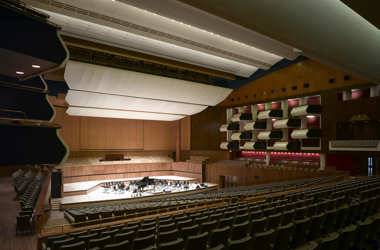|
|
|

Editorial
Board
London Editor:
(London UK)
Melanie
Eskenazi
Regional Editor:
(UK regions and Worldwide)
Bill
Kenny
Webmaster:
Bill
Kenny
Music Web Webmaster:
Len
Mullenger



|
MusicWeb is a
subscription-free site
Clicking Google adverts on our pages helps us keep it that way
Seen
and Heard Concert Review
Mahler,
Symphony No 3, Knussen, Violin
Concerto:
Michelle DeYoung (mezzo-soprano),
Christian Tetzlaff (violin), Esa-Pekka
Salonen (conductor), Philharmonia
Orchestra, Ladies of the Philharmonia
Voices. Choristers of Westminster
Abbey, Choristers of St. John’s
College, Cambridge, Royal Festival
Hall, 12.6.2007 (AO)

Royal Festival Hall Interior - Picture
© Richard
Bryant
( NB This picture is completely rectangular even though the perspective makes it
seem otherwise. Ed )
The newly refurbished Royal Festival
Hall officially opened with a gala
celebration featuring four orchestras,
three conductors and seats costing
£500. This concert, though, was the
first “real” taste of what we have
ahead.
Mahler’s Symphony No 3 was a brilliant
choice of programme. The Symphony
celebrates rebirth, re-growth, the
coming of summer, and the triumph of
life over adversity. Triumph after
struggle accurately describes the new
Royal Festival Hall, bedevilled for
decades by architectural compromise.
Indeed, this symphony – and this
programme in particular – could have
been designed to test the new Hall’s
acoustics.
This was an interpretation that
celebrated the clear, diaphanous
aspects of Mahler’s shining vision of
life, with remarkable clarity and
precision. Mahler wrote the symphony
on the shores of the Attersee. Thus
the imagery of open vistas over the
lake, light on moving waters, scented
meadows, and the clear mountain air he
prized so greatly. It was a delight
to hear an interpretation that gave
such clarity to Mahler’s appreciation
of Nature. Hence the delicacy of the
slower passages, which allow solo
instruments to shine through, as if
they were tender new shoots of
growth. Salonen’s approach allows the
music to unfold without heavy handed
forcing. His textures are lucid,
diaphanous like light, clean and
understated. This performance brought
me back to the time I sat in Mahler’s
composing hut, looking out on the
vistas he would have known, the
shining lake and the mountains above.
Mahler would have reached Steinbach
through an arduous climb over a
mountain pass. The hushed rumbling
rolls of percussion evoked a sense of
dark depths, struggling ever upwards.
“Pan sleeps”, he wrote, "but gradually
gleaming flashes of brass grow ever
more insistent, as if something is
stirring." Trumpets, horns and
trombones play a pivotal role in this
symphony, and Salonen structures the
development of the first movement
around them, each entry signifying a
subtle advance. Much is often made
of the march-like elements in the
first movement, for Mahler wanted the
effect of “a military band on parade,
with such a mob (of onlookers) milling
about”. But there are several other
marches here, a funeral, the
procession of Pan and his drunken
followers, and the journey through
mountain peaks, and the onward rush of
summer itself. While Salonen
articulates the details, his sculpting
of the structure shows how are built
into the foundation of the movement,
giving the whole symphony forceful
direction.
In his original plans for the
symphony, Mahler used the term “Pan
awakes !”. As the writer Donald
Mitchell says, Mahler discarded his
titles like a builder discards
scaffolding when a building is
complete : but ignore the original
intention at your peril. Pan
represents a disorder, a powerful life
force that convention cannot
withstand. He drives away winter, and
all it symbolises. In an
interpretation as refined as this, the
wilder climaxes were created by
spirited playing. rather than outright
crudity. The very precision of the
playing made it possible for the
orchestra to sound like the
“uproarious rabble” Mahler had in
mind, because rabble is made up of
individuals, jostling together. The
impact came from individual
instruments, providing quirky
nuances. Salonen’s “rabble” is
achieved by much more subtle means
than merely cranking up the volume. I
would have liked a bit more swagger at
times, but given the overall vividness
of the interpretation, it’s only one
component of the whole. Alex Verney-Elliott,
who was with me, noted how brilliant
the trombone solo sounded, clear and
bright, yet tinged with a sombre sense
of mourning melancholy which greatly
enhanced the emotional impact. This
particular trombone solo isn't very
easy to sustain and it is not the
easiest instrument to get subtlety
from, but the soloist here made it
moan, groan and wail with great
persona and verve.
The second and third movements showed
an understanding of the place of this
symphony in relation to Mahler’s
earlier work. Some of the references
to Wunderhorn themes are
obvious, such as the kuk-kuk
theme, and ideas from Das
himmlisches Leben. Salonen also
appreciated more obscure details such
as the “light” motif which would be
incorporated in the Fourth Symphony,
juxtaposed with a gorgeously Romantic
swirl of melody, gradually morphing
into the famous Fischpredigt
adaptation which takes the song and
ideas from the Second Symphony into
new directions.
The new acoustic in the hall revealed
itself in the offstage passages. The
drums sounded as if they were in the
middle of the hall, though of course
invisible, and the brass “from on
high” sounded totally natural. This
aspect of the symphony works
exceptionally well in the Albert Hall,
where I can remember almost weeping
when I heard the Cleveland Orchestra
soloist in the 2005 Proms. This
wasn’t quite as intense emotionally,
but more intimate. Because the
trumpeter on stage wasn’t quite so
outclassed, the effect in this
performance was more in keeping with
the idea of a genuine dialogue between
heaven and earth, and fitted the
understated refinement of the overall
concept. Similarly, the critical
trombone and solo violin passages were
lucidly defined, the warmer acoustic
allowing them to play sensitively,
without having to worry about being
heard or not heard in the auditorium.
With each new concert, we’ll hear
different aspects of the acoustic, but
this was most promising.
Michelle DeYoung was magnificent. She
is one of the finest Mahler singers in
a crowded field, for good reason.
This was an elegant, dignified and
highly nuanced performance, truly
heartfelt yet not overstated. Very
carefully controlled vibrato warmed
her vowels, giving her delivery
depth. Alex was struck by the
intimate dialogue between voice and
clarinet here, as if the instrument
were a snake charmer, curling upwards,
urging the voice to rise sensually.
His note “sighing in sexual rapture
and rupture” is wonderful, and sums it
up beautifully. It was another
example of the detailed,
score-sensitive, chamber-like
approaches of contemporary conductors
like Abbado, Boulez and Harding so
respected by musicians at this level.
The Philharmonia delivered more for
Salonen than did the Los Angeles
Philharmonic in his recording of this
symphony with them a few years ago.
Since he’s now with the Philharmonia
long-term, the relationship will grow
and blossom.
Mahler may have removed his title
“What love tells me” but he built his
music around these ideas, only
removing the titles so that people
would think beyond the surface, and
listen. Nearly everything Mahler
wrote may have referred to death, but
his goal was always to overcome it,
seeking rebirth, resurrection,
redemption and transfiguration.
Ultimately, he’s life-focussed. He
doesn’t get off on death but is always
seeking solutions. He looks towards
the future, and to life. The Third
Symphony is easily his happiest. Pan
sleeps, but wakes, driving away the
gloom of winter with glorious, lively
Spring. The fifth movement is a clear
parallel. The singer sings of waking
from “deep, deep dreams”, then joins
the choirs in the rousing big number
that sweeps all before it. It is a
vision of eternal life, infinitely
stronger than temporal life, achieved
through love and faith. Himmlische
Freud, (heavenly bliss) is what
the whole symphony has been leading up
to. The mountains have been climbed,
the sleeper has woken, and the marches
have led us to a final destination.
We’re left with transcendent
happiness, the Seligkeit which
Mahler refers to again and again
throughout his entire output, but
often underestimated.
Alas, I was so focussed on Mahler that
I didn’t do justice to Knussen’s
Violin Concerto which had the
honour of being the first piece played
in a concert in the new Hall. It was
well played and clear, Tetzlaff doing
an excellent job, but nothing can
stand up to a Mahler symphony.
Anne
Ozorio
Back
to the Top
Back to the Index Page
|
Seen and Heard, one of the longest established live
music review web sites on the Internet, publishes original reviews
of recitals, concerts and opera performances from the UK and internationally.
We update often, and sometimes daily, to bring you fast reviews,
each of which offers a breadth of knowledge and attention to performance
detail that is sometimes difficult for readers to find elsewhere.
Seen and Heard
publishes interviews with musicians, musicologists and directors
which feature both established artists and lesser known performers.
We also feature articles on the classical music industry and we
use other arts media to connect between music and culture in its
widest terms.
Seen and Heard
aims to present the best in new criticism from writers with a radical
viewpoint and welcomes contributions from all nations. If you would
like to find out more email Regional
Editor Bill Kenny. |
|
| |
|
Contributors: Marc
Bridle, Martin Anderson, Patrick Burnson, Frank Cadenhead, Colin
Clarke, Paul Conway, Geoff Diggines, Sarah Dunlop, Evan Dickerson
Melanie Eskenazi (London Editor) Robert J Farr, Abigail Frymann,
Göran Forsling, Simon Hewitt-Jones, Bruce Hodges,Tim Hodgkinson,
Martin Hoyle, Bernard Jacobson, Tristan Jakob-Hoff, Ben Killeen,
Bill Kenny (Regional Editor), Ian Lace, John Leeman, Sue Loder,Jean
Martin, Neil McGowan, Bettina Mara, Robin Mitchell-Boyask, Simon
Morgan, Aline Nassif, Anne Ozorio, Ian Pace, John Phillips,
Jim Pritchard, John Quinn, Peter Quantrill, Alex Russell, Paul
Serotsky, Harvey Steiman, Christopher Thomas, Raymond Walker, John Warnaby,
Hans-Theodor Wolhfahrt, Peter Grahame Woolf (Founder & Emeritus
Editor)
|
Site design: Bill Kenny
2004 |

